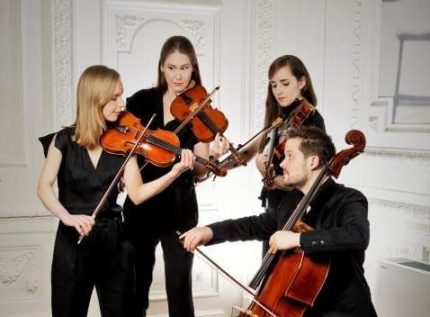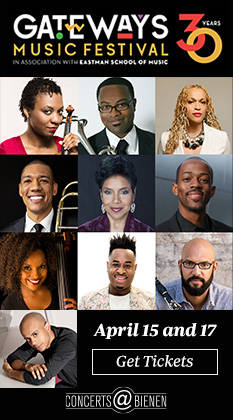Dudok Quartet steps outside the canon for inspired Winter Chamber Music Festival performance

With two and a half centuries of literature by most of Western music’s finest composers at their disposal, string quartets that wish to expand the repertoire traditionally have done so by commissioning new works. But an emerging trend seeks growth in the opposite chronological direction: arrangements of past works not written for quartet.
This is not an easy feat considering that the string quartet, in both the form and instrumentation, had a more definitive origin story than most genres, thanks to the inventive and prolific pen of Haydn. But this season patrons of the Winter Chamber Music Festival at Northwestern University’s Bienen School of Music have heard examples from two young quartets of arrangements of works from previous eras. Impatience with the sacred, canon-affirming three quartet sequence in string quartet programs seems to be the order of the day.
On Friday the Aizuri Quartet presented reconfigured works by Gesualdo and Hildegard von Bingen. On Sunday in Pick-Staiger Concert Hall, the Dudok Quartet Amsterdam introduced festival attendees to a suite, Choeur des Spartiates, from Rameau’s opera Castor et Pollux, arranged by the group’s cellist, David Faber.
The quartet performed this charming if lightweight score with an ear to modern conceptions of historically informed performance practice, aided by convex bows, and nearly unadorned with vibrato. As in all of Dudok’s repertoire, the quartet’s timbres matched with uncanny exactitude, and balances were precisely calibrated.
Most of the evening’s repertoire mined French sensibilities to varying degrees, and the emphasis on color and a lilting rhythmic profile gave their Rameau a tasteful yet unmistakably Gallic sensibility. French Baroque composers were nearly obsessed with ornamentation, so one could have imagined more such decoration in their reading.
The placement of a Hadyn quartet before intermission, rather than as program opener, signified the centrality of the composer in the foursome’s brief history. And indeed, coming after the Rameau,Haydn’s Quartet No. 2 in C major seemed to gain in gravitas from its usual introductory role.
The Op. 20 quartets are his first set of unqualified masterpieces. No. 2 in C major looks both backward in its Baroque fugal techniques and forward in its more egalitarian use of all four string players. The opening cello solo is exhibit A in this new democracy, and Faber made the most of his opportunity with a fluid, seamlessly sculpted reading.
The sublime Adagio opens with the players in octaves, an operatic signal to listeners that something of dramatic import is at hand. Dudok never rose above a mezzo-forte in the entire quartet, but the limitless array of quiet shadings — always feathered a niente — paid handsome dividends.
Haydn’s drones at the opening of the minuet are no doubt a reference to the hurdy gurdy, an instrument the composer would have often heard in the streets. Their performance could have adopted a more rustic approach to reflect Haydn’s populist bent, but their unflappably elegant style was nevertheless fully engaging.
Faber’s haunting version of an excerpt from Messiaen’s Fête des belles eaux (originally composed by the unlikeliest of ensembles: a sextet of Ondes Martenot, an early electronic instrument) served as an introduction to an alluring account of Ravel’s String Quartet in F major.
The opening movement unfolded with a sumptuous statement of Ravel’s motto theme, while the octave melodic passages of violinist Judith van Driel and violist Marie-Louise de Jong fairly glowed with radiant nostalgia. The foursome’s opening pizzicatos in the scherzo popped with youthful brilliance, and the composer’s infatuation with Spanish rhythms have rarely sounded so authentically idiomatic.
Every attribute of this superb group coalesced in a sublime, incandescent account of the third movement. Ravel recycles his motto theme in altered form in the opening, and the ensemble’s muted strings and softened color palette bathed the composer’s plush harmonies in an enveloping warmth.
The finale surged with breathless abandon, and while the quartet effortlessly managed the quicksilver pace, the listener barely had a chance to let the performance’s telling details register. This was a rare miscalculation in a program that otherwise showed ample justification for the ensemble’s place of honor in this golden age of quartet playing.
The Dutch players weren’t content to leave even the conventions of encores unexamined, as they delighted the audience with a bracing account of the third movement of Ligeti’s String Quartet No. 2.
The Winter Chamber Music Festival concludes with two more concerts at Pick-Staiger Concert Hall: Bienen faculty and guests perform Beethoven and Brahms, 7:30 p.m. Friday, January 24; and American String Quartet performs Haydn, Respighi and Schubert, 7:30 p.m. Sunday. music.northwestern.edu
Posted in Uncategorized




